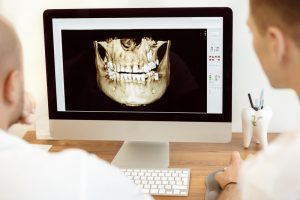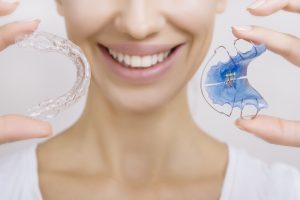What’s New with Orthodontic Technology?
5 Dental Habits to Break this Year!
January 11, 2018Permanent Retainers: How Long Will You Need One?
January 23, 2018
Orthodontics has been around since the 18th century, but treatment methods definitely don’t look the same as they did then. Consider the following new advancements in orthodontic technology this century such as: digital x-rays, 3D dental imaging, Invisalign, removable retainers, ceramic braces, TADs and digital impressions. How can you benefit from these technologies this year?
A Brief History
Did you know that the Ancient Egyptians and Ancient Greeks had orthodontic technology? Mummies have been found with metal appliances on their teeth, which were used to straighten teeth as a person entered the afterlife. The Etruscans, Romans and many other societies had various forms of orthodontic technology to get a straighter smile. Over the centuries, writers and scientists suggested various methods for straightening the teeth. Celsus recommended pushing the teeth with your fingers to get them straighter. A Roman named Pliny the Elder advised filing teeth to the size you wanted them to be. Others even recommended forcefully moving and turning the teeth and tying them to neighboring teeth until they healed in place.
Barbers and medical professionals used to forcefully pull teeth or work on tooth decay with crude instruments. Now, however, orthodontic technology is incredibly advanced with simple solutions to provide you a straighter smile virtually pain-free!
Digital X-Rays
Orthodontic technology advanced incredibly fast when digital technology came around. Dentists and orthodontists alike use digital devices to find and correct problems. An orthodontist uses digital x-rays to detect bite and alignment problems early-on in children. Your child should have their first orthodontic visit between ages 7 and 8 when the jaw is still forming. Through x-ray imaging, we can see where the baby and adult teeth lie, how those adult teeth will come in, and if we need to fix bite and alignment problems. X-ray imaging allows us to correct those problems before they become severe. That wasn’t possible in the past.

Digital Impressions and Imaging
Digital impressions came on the scene in the 17th century. Mattheaus Gottfried Purmann first used wax to make impressions of the teeth. Eventually other scientists and orthodontists created various molds to make exact models of the teeth. These models help orthodontists see how your teeth are and how they need to be moved during orthodontic treatment. However, even impressions have gone digital.
Now, special machines are used to map out the inside of your mouth using laser light. Our tools can create a 3D image of your mouth, which allows us to create a model of your teeth. Our systems even allow us to map out a trajectory of your entire orthodontic treatment from start to finish. In centuries past, the length of your treatment and the outcome were complete guesses. Now, they don’t have to be!
New Types of Braces
Although traditional metal braces were the only option for patients in the past, orthodontic technology now allows patients lingual braces, clear braces and Invisalign treatment. Lingual braces are similar to metal braces, except that they are attached to the back of your teeth. This option is a great way to straighten your teeth in secret. Clear braces are braces made of white ceramic material that match the whiteness of your teeth. They look like metal braces and have brackets and archwires. However, they are white, making them fairly unnoticeable.
Invisalign Treatment
Invisalign is the most discreet orthodontic technology there is. At least 1/4th of people with braces are adults, and adults generally want a straighter smile without a mouth full of metal. Invisalign is a series of transparent aligners that fit snug on the teeth. You switch out these aligners every week and your teeth slowly move into a straight position. Your time with Invisalign is either the same or shorter than metal braces.

Removable Retainers
In centuries past, there wasn’t orthodontic technology that kept the teeth in place. Retainers are appliances we give you after your orthodontic treatment to keep your teeth straight. In decades past, orthodontic technology only went as far as providing a removable retainer that you wore at night. Now, we can provide permanent retainers to the back of your teeth to keep them in place. These retainers are consist of either a wire that goes across your front 4-5 teeth, or wires attached to each individual tooth and cemented in place. These permanent retainers ensure that your smile stays beautiful for decades to come!
Temporary Anchorage Devices
TADs is short for temporary anchorage devices. These devices shift the teeth into straighter positions when braces alone can’t do the job. TADs are titanium, screw-like devices that are placed in the gums to move the teeth. These screws are between 6-12 mm in length and can be placed right into the bone. Many patients won’t ever need TADs, but they can help accelerate your time with orthodontics.
Invest in Orthodontic Technology
There has never been a better time to have braces. Orthodontic technology is the best it has ever been, helping your braces experience be an enjoyable one. Not only can braces make your teeth straighter, but a straighter smile can also increase your confidence and success. To schedule your free consultation for your set of braces, call Hardy Pediatric Dentistry & Orthodontics today at (720) 887-6003!